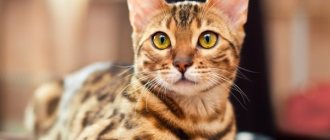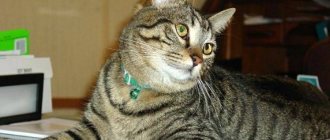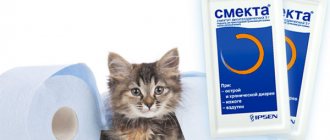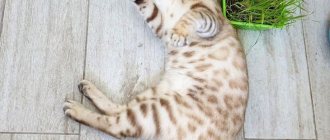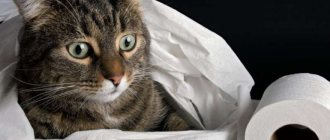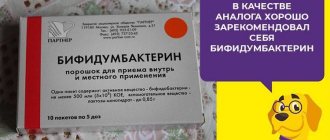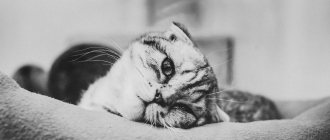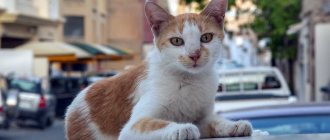Normal heart rate in a cat
Anyone who is used to monitoring their health knows that the pulse in adults ranges from 60 to 90 beats per minute, from 110-170 in infants and from 60 to 100 in adolescents. Unfortunately, not all owners know what a cat’s normal pulse is. It is believed that in an adult healthy animal the pulse value ranges from 100 to 140 beats per minute. At the same time, large cats have a lower heart rate than their small counterparts, and females have a slightly higher heart rate than males. Kittens' pulse is always high: from 150 to 190 beats per minute. And a cat’s pulse at a very advanced age may be slightly lower than normal: 80-100 beats per minute.
Methods for measuring heart rate in cats
Sometimes, in order not to miss any disease in your pet, it is enough to simply measure its pulse in time. Let's look at how this is done. We humans, when we want to count our heart rate, we squeeze the wrist area. Where is a cat's pulse? The easiest way for an animal to feel the pulsation of the large femoral artery is to press on the inside of the thigh (in the groin, where the cat's leg connects to the body). But here we note that some wayward pets may simply not allow the owner to touch the groin area. Otherwise, the pulse of a cat, cat or kitten can be measured by pressing the palm of your hand on the area of the sternum on the left side (where you can feel the heart beats). The cat's pulse rate is usually measured over 1 minute. But what if the cat is indignant (breaks out, tries to bite, hisses, etc.)? Measurement time can be halved or quadrupled. For an aggressive pet, the measurement time can be reduced to 15 seconds, and then simply multiply the resulting value by 4 (the result of a 30-second measurement must be increased by 2). When figuring out what your cat's heart rate is, it's important to keep these things in mind:
- Pulse counting should be done when the animal is as calm as possible. An excited cat's pulse is always significantly higher than normal;
- During the measurement, the owner should under no circumstances shout at the cat, hit or squeeze it forcefully. This will cause the pulse of the unnerved animal to jump up;
- You should not take the pulse of a sleeping pet. During sleep, cats' heart rate is lower than when awake;
- There is no need to put too much pressure on the cat's groin or chest. With strong pressure, it is difficult to calculate the pulse rate correctly.
Basic information
Also, the causes may be the consequences of heart disease, which lead to heart failure, metabolic disorders, filling the space in the chest with harmful substances, as well as the presence of foreign objects, for example, a piece of food that has fallen into the wrong throat, or plants, especially with sharp stems and leaves.
Firstly, what is a pulse? These are vibrations of the walls of blood vessels through which not only blood flows, but also “recoil” from heart contractions. Naturally, this is typical exclusively for arteries, since blood flows through the veins to the heart, which draws it in like a living pump.
Normally, a cat's heart rate ranges from 120 to 140 beats per minute. But it may be less if we talk about cats of “giant” breeds, like Maine Coons. How can you feel it in your pet? No, you don’t need to touch his paw, since in cats the pulse is found by pressing your palm to the inner surface of the thigh.
The femoral artery vibrates noticeably there, and therefore it will not be difficult to do this. Remember that kittens' heart rates are significantly higher than those of adult animals, so don't be alarmed if you lose count while trying to count them. In very young babies, the heart rate can easily reach 190 beats per minute. This is significantly higher than the normal heart rate in cats. But there is no need to worry, as this is a completely physiological phenomenon.
By the way, do not try to check the cat’s pulse by firmly grasping the cat by the throat (and such unique people really do exist). No, you can really determine the heart rate this way, but the animal will not be happy about it. In addition, his heart will be pounding from fear so that the correct readings will still not be obtained.
But what should you do if the cat is particularly chubby, or twitches its paws violently so that it becomes impossible to count the number of heartbeats? In this case, you should focus on the cardiac impulse. But how to measure a cat's pulse this way? This is the name for the “vibration” of the chest wall that occurs during heart contraction.
The cat's pulse is higher than normal
We found out above what a cat's pulse should be normally. But what if the pulse rate of an adult animal exceeds the specified limits, exceeding 150 beats per minute? Then we can safely talk about tachycardia - a pathological increase in heart rate. This is a dangerous disease that, if untreated, can lead to serious problems: ischemia, heart failure, thromboembolism, myocardial hypoxia, pulmonary edema and general deterioration of the body. If you do not seek medical help on time, unfortunately, death cannot be ruled out.
In addition to a rapid pulse, tachycardia in a cat can be recognized by the following symptoms:
- Severe, persistent weakness (the cat looks tired even if it moves very little);
- Arrhythmia (pulse is irregular, the heart beats either too quickly or too slowly);
- Frequent breathing, shortness of breath even after a quiet walk;
- Paleness of the mucous membranes;
- Possible cough;
- Loss of consciousness.
The most common causes leading to the development of tachycardia in cats include:
- Heart disease (cardiomyopathy, myocarditis, etc.);
- Diseases of the respiratory system, non-infectious and infectious (pulmonary failure, lung cancer, tuberculosis, pneumonia, etc.);
- Endocrine disorders (diabetes mellitus, hyperthyroidism);
- Inflammatory processes (pancreatitis, gastritis, colitis, endometritis, etc.);
- Blood parasitic infections.
If your cat's pulse is constantly elevated, you should visit your veterinarian (ideally, a veterinary cardiologist) as soon as possible. The specialist will take the animal’s blood and urine for analysis, conduct an electrocardiogram and echocardiogram, and, if necessary, an ultrasound and x-ray of the sternum and abdominal cavity. Treatment will be prescribed after an accurate diagnosis has been made. But we strongly recommend that you refrain from self-medication so that something irreparable does not happen.
Causes of accelerated heartbeat in cats
Accelerated heartbeat in cats is detected with the following diseases:
- heart damage: inflammation (myocarditis), non-inflammatory (cardiomyopathy), due to poor blood supply;
- respiratory failure due to obstructions to inhaling air, pneumonia, tumors, tuberculosis;
- diabetes;
- increased work of the thyroid gland;
- infection by parasites, viruses, bacteria;
- anemia (decreased levels of red blood cells and hemoglobin);
- inflammation of the digestive organs (colitis, enteritis, pancreatitis);
- postpartum endometritis.
An increase in heart rate is called tachycardia; if it exceeds the norm by more than 30%, it is dangerous for the animal. A sudden attack can cause disturbances in the nutrition of the heart, brain, arrhythmia with stopping contractions. Prolonged acceleration of the rhythm leads to depletion of the strength of the heart muscle, a general deterioration of the condition, when the cat moves little, looks exhausted, and does not eat. As circulatory disorders progress, shortness of breath, coughing, and loss of consciousness occur.
The cat's pulse is below normal
Tachycardia or rapid pulse is a dangerous disease. What if the cat’s pulse is below normal? This is also bad: bradycardia (low pulse) leads to severe weakness, the formation of blood clots, with this disease the internal organs are poorly supplied with blood and quickly fail. In addition, this is also dangerous, since with bradycardia, animals often lose consciousness. Sometimes bradycardia is accompanied only by weakness, but in advanced cases the following symptoms may be present:
- Impaired coordination of movements (the cat has a “drunk” gait);
- Fainting;
- Arrhythmia;
- Periodic seizures;
- Jumps in blood pressure (normally, a cat’s blood pressure ranges from 105/65 to 135/95 mm Hg);
- Labored breathing.
Bradycardia in a cat is not an independent disease. This is a symptom of other serious illnesses:
- Poisoning (insect and snake poisons, lead, pesticides, etc.);
- Heart problems (myocarditis, cardiomyopathy, aortic stenosis, etc.);
- Sepsis in infectious diseases or as a complication after surgery;
- Hypothermia;
- High intracranial pressure due to traumatic brain injury and brain diseases (meningoencephalitis, meningitis, epilepsy, etc.);
- Heavy bleeding;
- Hypothyroidism;
- Anemia;
- Constant stress;
- Overdose of cardiac drugs.
It is possible to rid a cat of bradycardia if the cause of the low pulse is determined. To make a correct diagnosis, the doctor will prescribe urine and blood tests, as well as important studies: ultrasound and x-ray of the heart, as well as an electrocardiogram.
Attack of tachycardia in a cat
Hello! Today our cat (mongrel, not sterilized, 10 years old) had something like a seizure, but first I’ll probably describe our medical history, it’s quite long, but so as not to miss anything I’ll describe the whole situation. In general, our diagnosis was breast cancer, based on the results of histology after surgery to remove one affected ridge of breast tissue in February of this year. Tests were done before the operation, everything was fine, the ultrasound of the heart showed nothing wrong, except for minor age-related changes. She recovered normally after the operation without any complications, all tests were normal, X-rays of the lungs and ultrasound results showed no metastases. However, a relapse occurred, the tumor began to form and grow in the lymph node on the side from which the first ridge was removed. Then, in March, we carried out the first stage of chemotherapy with Doxorubicin, she tolerated it normally, only sporadic vomiting, good blood tests before and after. After 2 weeks, on March 31, the second stage of the operation was performed, the second ridge and the affected lymph node were removed. The operation was successful, the only thing they say was that there was a pressure surge. They left him in the hospital for a day, but the cat was under severe stress, the temperature remained at 40, and they decided to take her home. The first days after the operation I felt fine, but gradually I began to eat less and had no bowel movements for about a week. 5 days after the operation, on April 5, we completed the second course of chemotherapy (we have it once every 3 weeks). The cat was already very lethargic by the time of chemotherapy, did not eat, had no stool for a week, and was thirsty. They did an enema, there was only a single stool, they prescribed an IV, they also did biochemistry for kidney parameters, which turned out to be 3 times too high (urea 27, creatinine 600, potassium 5). They prescribed drips, also gave Duphalac and Acilok for constipation, tried to force-feed him purina NF, but not very successfully. On the third day of drips, i.e. Yesterday we decided to leave the cat for a day hospital, for IV drips at a constant rate. Yesterday they again took a blood test for general and biochemistry tests, plus a urine test. According to the analysis, everything was fine, kidney parameters dropped to normal, potassium was slightly elevated. Urine analysis is normal in density. In general, it showed a low level of leukocytes, they gave an injection of Epocrine 1000. They measured blood pressure and temperature, everything was normal, but the cat was under severe stress in the hospital and behaved aggressively, although she was always very calm at appointments with me. They took her home, she even ate a little on her own. Everything was fine, she fell asleep, she trembled a little in her sleep, but it seemed normal to me, although the last few days her breathing seemed a little faster and heavier, but when we listened to her, everything was normal. At about 3 o'clock in the morning today she suddenly woke up, jumped up, her paws began to move apart, she could not stand, she was like a rag doll. Then she opened her mouth, drooling began to flow, she stood there for a couple of minutes, but I didn’t notice any rapid breathing. Nevertheless, they were urgently taken to the clinic, i.e. 10 minutes passed from the beginning of the attack, on the way the condition improved a little, she stood firmly on her paws, closed her mouth, but was a little lethargic. Upon arrival to the doctor (in total, 20 minutes passed from the beginning of the attack), upon examination they found only tachycardia, slightly rapid breathing, they did not take tests, because took them 12 hours ago. Temperature 38.2. The doctor determined the eye pressure to be normal. We gave an injection of Relanium and prescribed Vazotop 0.5 mg once a day for life and Kot Bayun or Novopassit, but we already added Kot Bayun to her water, because... trips to the clinic frighten her very much, she has become more nervous and irritable. Upon arrival home, she ate well, but as I understand it, this is the effect of Relanium, now she is sleeping, but often wakes up. The heart rate is currently normal at 120 beats per minute. But my breathing is rapid, 40-45 breaths per minute. There is also a slight trembling in the body (and this is after Relanium). There is still no bowel movement for 4 days, although I give Duphalac. Of course, she ate almost nothing these days, but there was no stool or even the urge to stool at all.
How to measure a cat's pulse
- cat diseases Poor appetite in cats
- Treatment of diarrhea in a cat
- Diseases of the nervous system in cats
- How to castrate cats and female cats
- Obesity in domestic cats and kittens
- Cat skin and its derivatives
- Tumors
- Feline eye diseases
- Causes and ways to eliminate bad breath in cats
- Digestive system of a cat
- Causes of vomiting in cats
- Kidney diseases
- Respiratory system diseases in cats
- Cannibalism and other pathologies in cats during childbirth
- Feline skin diseases
- Cat's eyes
- Discharge from the eyes and nose in cats
- Hypersalivation (increased salivation) in cats
- If your cat drinks a lot of liquid
- Constipation in cats
- Diseases of the urinary system
- Diseases of the reproductive system in cats
- Uterine prolapse and hernia in cats
- Poor growth and hair loss
- cat nose
- Respiratory tract infections in cats
- Diseases of cats with inflammation of the oral cavity
- Adult cat or kitten
- British brindle cat
- Organization of control of intestinal parasites in the nursery
- The relationship of a cat to a person
- Poisonous plants for cats and other dangers
- Stopping bleeding in cats
- Accessories for cats in the nursery
- Complete nutrition for cats
- When kittens start walking: transition period and socialization
- Blue Eyes
- Puberty in cats.
- Blood types in cats
- Caring for your cat before shows and during normal times
Heart pathologies in cats
The heart of pets, like the human heart, is also susceptible to various diseases. Pathologies of the cardiovascular system can be either acquired or congenital. Large Maine Coon, British and Scottish breeds, as well as Persian, Abyssinian, and Sphynx breeds have a genetic predisposition to heart defects.
Many heart diseases develop gradually, often over several years. And when the animal begins to show clinical signs, the body usually already has serious disorders.
Cardiomyopathies are the most common heart pathologies in cats. The reasons for their occurrence often remain unclear.
Hypertrophic cardiomyopathy (“fat big heart”) is a major feline heart disease characterized by thickening of the heart muscle and therefore decreased ventricular volume. If detected early, this disease can be treated quite well, and improving the nutrition of the heart muscle and reducing the load on it can keep the pet healthy for many years.
Other heart diseases:
Inflammatory pathologies (myocarditis and endocarditis) are of both infectious and non-infectious (aseptic) nature.
When a cat’s immune system is significantly weakened due to some kind of infection, for example, a viral one, then pathogenic bacteria (sometimes fungi) can penetrate into the lining of the heart with the blood flow and cause septic inflammation, which, without timely treatment, can result in acute heart failure.
Non-infectious inflammation of the heart muscle occurs in cats as a result of the use of certain medications (for example, cytostatics, painkillers or anti-inflammatory drugs (NSAIDs)).
Myocarditis is an inflammatory lesion of the heart muscle that occurs as a complication of sepsis, pancreatitis, panleukopenia, pyometra, uremia, and acute intoxication. Myocarditis can be acute or chronic and manifests itself in heart rhythm disturbances.
Myocardosis is a non-inflammatory heart disease characterized by dystrophic processes in the myocardium (the muscular layer of the heart). Its development is caused by unbalanced feeding, intoxication due to chronic infectious, invasive, gynecological and other non-contagious diseases.
Secondary cardiomyopathies in cats occur as a consequence of diseases of other organs, for example, with abnormalities in the thyroid gland (hyperthyroidism). Continuous tachycardia due to increased levels of thyroid hormones in the blood leads to a thickening of the wall of the left ventricle of the heart and, consequently, a decrease in the volume of ejected blood. At the same time, the heart works hard.
Congenital pathologies (cardiac arrhythmias and disorders of the heart valves) are usually associated with underdevelopment of the valvular apparatus of the heart, with disruption of the generation and conduction of nerve impulses to the myocardium, resulting in severe arrhythmias.
But severe genetic heart abnormalities in adult cats are rarely diagnosed, as they usually lead to the death of kittens at an early age.
Congenital pathologies of the heart of cats: patent ductus arteriosus, narrowing (stenosis) of the pulmonary artery, stenosis of the aortic mouth.
Cardiac arrhythmias are not necessarily initially associated with diseases of the heart itself. They can occur in various diseases of other systems and organs. But with prolonged secondary arrhythmia, pathological changes will eventually appear in the heart muscle itself.
How to measure your heart rate correctly
First of all, you need to know how to measure a cat’s pulse without having any special skills. In order to feel the pulse, we need to feel a large artery - it is in these vessels that the pressure is highest, and the movement of blood is well determined by the fingers.
You shouldn't do research after chasing a cat for two hours and trying to fish it out from under the sofa. It’s better to wait until the animal is lying quietly or sleeping, then the indicators will be most accurate, and you won’t have to think about what the cat’s pulse should be after physical activity.
The femoral artery is usually used to measure the pulse: it is quite close to the skin and is easy to find without special knowledge of animal anatomy. We place our palm on the cat’s inner thigh, press it against the body and feel a slight rhythmic pulsation - now we know where the pulse is measured most often in cats.
Of course, if it is impossible to determine it on the hip, you can carefully grab the animal’s throat or place your palm in the area of the first 5 ribs on the left, but these methods are less convenient and the animal may not like it.
After we have found the pulse, we note the time (1 minute, 30 or even 15 seconds) and count the number of beats. If you timed 30 seconds, multiply the value by 2, if 15, by 4. It’s better, of course, to time a minute at once, but this can be difficult to do for many reasons (due to the high heart rate of cats, it’s easy to lose count; a cat may not be able to withstand a minute in this position, etc.).
Changes in pulse and the reasons for this phenomenon
A change in pulse accompanies pathological processes in the animal’s body. Changes in heart rate may be normal. For example, an increase in heart rate (tachycardia) can occur after active play, running, or when the pet is excited, as well as during the period of estrus (especially March-April). Mild bradycardia (low heart rate) may occur during sleep and immediately after the cat wakes up.
Reasons for changing filling
The volume of blood in the vessel at the peak of pulsation is called “filling”. Normally, pulsation is characterized by moderation. Full pulse is determined in hypertension. In case of hypotension, loss of blood, fainting, dehydration, tachyarrhythmia, the pulse will be empty, that is, difficult to palpate. An almost non-palpable pulse will occur when the animal is in a comatose or shock state, massive blood loss, or collapse.
Reasons for voltage changes
This characteristic is determined by the force that must be applied to completely compress the artery. The pulse should be of moderate tension.
With high blood pressure numbers, especially increased systolic pressure, the pulse may be hard. This indicates the need for medical intervention to prevent strokes or heart attacks.
A soft pulse characterizes the exact opposite state, that is, a decrease in blood pressure. This happens when there is blood loss and dehydration, due to a decrease in the tone of the vascular walls or the ineffectiveness of the contractile activity of the myocardium.
Reasons for changing frequency
The number of myocardial contractions per unit time is called the pulse rate. You need to understand that when determining the pulsation in the arteries on the inside of the animal’s thigh and the number of myocardial contractions, the numbers may differ. This happens when the myocardium sends too small portions of blood into the vascular bed (heart failure, blood loss, dehydration).
Tachycardia can be observed with anemia, infectious diseases that occur with an increase in body temperature, heat stroke, and endocrine disorders. With dehydration, stress, or shock, the pulse may also become shorter. Experts usually associate bradycardia with cardiovascular diseases.
Reasons for changing the pulsation shape
The shape is the rate at which the volume of the arteries changes. A fast pulse is a pulse in which the pressure increases greatly during systole and rapidly decreases during diastole. Such a pulse indicates insufficiency of the aortic valve apparatus, anemia, and fever.
A slow pulse characterizes the exact opposite situation to that described above. It occurs with a minimum pressure difference in the systole/diastole interval. Such a pulse may indicate a narrowing of the aortic ostium and insufficiency of the myocardial valve apparatus.
Dicrotic (double/two-humped pulse) occurs when blood hits a closed valve. This condition occurs in severe cardiomyopathies. Sometimes such a pulse is palpated in a young animal during an illness accompanied by fever.
Reasons for height changes
The amplitude of oscillations of the vascular wall is usually called the pulse height. The animal should have a uniform or moderate pulse in height.
High pulse amplitude is possible with aortic insufficiency, endocrine pathologies, and severe fever.
A cat may have a small pulse amplitude when the volume of circulating blood decreases, with heart failure, or stenosis of the aortic ostium in a state of shock.
Reasons for rhythm changes
Rhythm refers to the intervals between heartbeats (pulsations). At equal intervals, the pulse is considered rhythmic; at different time intervals between pulsations, they speak of arrhythmia. In general, arrhythmias include tachycardia, bradycardia and arrhythmia itself. Arrhythmias can be sinus and ectopic.
Relative and absolute (atrial and ventricular flutter). Arrhythmia characterizes various pathologies and myocardial defects.
Normal heart rate for cats and cats
What is a cat's normal heart rate? In adult animals, heart rate can be affected by many factors, including:
- weight;
- age;
- physiological state;
- emotional condition;
- breed;
- presence of pathologies.
The normal pulse rate for a medium-sized cat that does not suffer from serious illnesses is from 110 to 130 or, according to various sources, 140 beats per minute.
Breathing Features of Cats
The breathing process of a cat is not fundamentally different from other mammals, including humans. When an animal breathes, air is drawn in through the nose, enters the larynx, and from there through the trachea is sent to the lungs. Next, oxygen is picked up by the blood and distributed to all organs of the body. "Waste" goes back along the same path:
- lungs;
- trachea;
- larynx;
- nasal passages.
In a calm state, a cat breathes approximately 30 times per minute, that is, every two seconds. The norm is the number of breaths from 20 to 40. In kittens this figure is slightly different and can reach 50 times.
Another reason for deviation is the female’s prenatal condition or estrus. All these situations can be considered a variant of the norm. Very little time passes, the cat calms down and breathes as usual again. However, sometimes we are talking about deviations.
The heartbeat as a small impulse or ejection of blood from the heart can be detected in large arteries.
In a cat, the main artery is located on the right or left thigh, on the inside of the hind leg. The pulsation, each blow will be easy to track in the groin area. This place is palpable. It is not recommended to feel the cat's pulse with your thumb. Doctors have proven that a person’s own heartbeat can confuse or distort the results of the examination.
What is the normal heart rate for cats and kittens? This indicator may be affected by:
- weight and physiological body structure (direct relationship);
- mental state of the animal;
- his age;
- breed;
- the presence of chronic diseases or acquired pathologies.
The average, that is, normal indicator is considered to be 110-135 beats per minute. For a kitten, the norm ranges from 200 to 220 beats. According to some SI, the norm for small animals is 240 beats.
Knowing these features and strictly following the standards of medical ethics, our veterinarians will determine the pulse of a young cat or an adult cat.
We advise you to take these indicators into account when further treating, rehabilitating or preventing the development of diseases in your pet. To begin working with the animal, we invite you to examine it and conclude an agreement confirming your consent to a medical examination of the kitten.
Our veterinarians will first examine your pet, then wait until his frequent movements are minimal and his condition is calm.
Then the specialist places his palm on the thigh, supporting the animal’s body with the other hand, without tilting its head low. A slight pulsation can be easily felt on the hind leg. We take measurements within a minute. Such results are the most reliable.
If it is impossible to determine the heartbeat in the described way, our veterinarians lightly clasp the cat’s chest, pressing its shoulder blades against the specialist’s body. On the left side, in the area of the first ribs, you can feel a proper light push, repeated with a certain rhythm. This will be the heart rate in cats.
If we are unable to determine the heart rate per minute, the measurements of the given units are fixed at 15 or 30 seconds and then multiplied by 4 or 2, respectively. The results are recorded in the pet's card.
https://www.youtube.com/watch?v=ytadvertise
READ What can Djungarian hamsters eat, a list of what can and cannot be fed.
For additional information on measuring temperature, respiratory rate or pulse, you can contact us by phone or by making an appointment at the online registration desk.
Heartbeat disturbances indicate any abnormalities in the cat’s health, that is, it is a symptom of a disease.
Rapid pulse:
- anxiety;
- fever;
- shock;
- dehydration;
- heatstroke;
- infection.
Excessively slow heart rate:
- heart disease;
- circulatory disorders.
An irregular pulse indicates an arrhythmia.
Normal heart rate for a kitten
The smaller and younger the animal, the faster its pulse will be. The normal heart rate for kittens is from 200 to 220 or even 240 (for the smallest) beats per minute. In newborn babies, it may be easier to measure the indicator by placing your fingers in the area of the heart, since the pulse at the hip may be difficult to palpate.
An experienced owner who knows what the pulse of a kitten and an adult cat is will always be able to determine the severity of his pet’s condition in critical situations and convey this important information to the veterinarian.
In films and books, a person who shows little or no signs of life is first checked for breathing and a pulse. And this is quite justified, by the way. In veterinary medicine, the pulse of a cat (or other animal) is also of no small importance, since its readings can be used to judge the general health of the pet, as well as determine the presence of certain pathologies of the cardiovascular system.
Breathing rate and heart rate
The respiratory system of felines functions similarly to humans - air enters through the nostrils, passes into the upper part of the windpipe, trachea, and then into the lungs. The frequency of respiratory movements is normal if the animal in a relaxed state takes 20-50 breaths in 60 seconds. In kittens, due to accelerated metabolic processes, the indicators vary from 30 to 50. With good health indicators, the cat’s pulse rate is 100-130 beats/min. The heart rate of babies can reach 150 beats per minute. However, when measuring indicators, veterinarians recommend paying attention to the following factors:
- The breathing of a cat in position, during lactation and estrus, becomes more frequent, which does not indicate abnormalities.
- Due to exposure to stress factors, such as moving, noise or play, cats begin to inhale air through their nose more intensely.
- In hot weather and high air humidity, the respiratory rate increases 1.5-2 times.
- You need to measure your pulse and breathing adjusted for the time of year. In winter, the breathing of animals slows down and is almost inaudible.
- Large cats breathe less frequently than small cats because the latter have a faster metabolism.
Acceptable living parameters for your pet
It was previously mentioned that it is very important that your first aid kit contains information about the normal physiological values of your patient. Why is this necessary? For several reasons:
- Deviation from these norms can be a warning sign for you that something bad is happening to your animal.
- The list will allow you to assess the severity of the violations. For example, a temperature of 39.3°C is only slightly elevated, since in normal condition it is 38.9°C. This will facilitate first aid and help answer the question of whether it is worth contacting a veterinarian.
This means that it is very important to learn how to determine the basic vital signs that are common for your four-legged companion.
What is the pulse like?
This question is very important. More precisely, the answers to it are important. So, the main type of pulse is normal. This means good content, low tension, rhythm... In short, there are a lot of incomprehensible words, the meaning of which is better described separately.
So what is filling? Roughly speaking, this is the quantity, the volume of blood in the artery. Poor filling, accordingly, is observed with severe dehydration, intoxication and other serious pathologies. When well filled, the vessel is elastic, but not “hard”. An increased value of this indicator may indicate various heart diseases, which, as a rule, are accompanied by edema.
Capillary refill time
Capillaries are microscopic blood vessels that reach almost every cell of the body. They are what gives the skin its pink color. By checking the capillary refill time, you can assess the condition of the cardiovascular system.
What is the best way to do this so that treating cats at home does not cause problems? Follow the steps below:
- Lift your pet's upper lip and use your finger to pull back the pink gum tissue. This will cause a short-term leakage of blood from the vessels and stop its flow in this place.
- Then release the pressure. Notice that a pale spot appears on the area of the gum that you pulled back.
- Now check how long it takes for its normal pink color to return. It is this period that will be considered the period during which the blood vessels are filled with blood again and will be called capillary.
Most often this interval is 1-2 seconds. In situations where the time increases to 2-4 seconds, you should consult a veterinarian. This may be due to dehydration or shock. And, when the capillary time is more than 4 seconds or less than 1 second, this is an emergency that requires an immediate visit to the clinic.
Symptoms
Oddly enough, an increase in heart rate of more than 140 per minute that occurs suddenly is usually well tolerated by patients. Such an attack can even last for several days, and the patient does not notice it or only feels weakness that is incomprehensible to him.
The more the heart muscle is affected and the more severe the heart disease, the more signs appear during an attack of tachycardia:
- chest pain;
- shortness of breath, lack of air, especially when lying down;
- sweating, severe weakness;
- dizziness, clouding of consciousness;
- fainting, loss of consciousness.
In the most severe cases, there is a risk of developing a stroke.
Tachycardia or rapid pulse is a dangerous disease. What if the cat’s pulse is below normal? This is also bad: bradycardia (low pulse) leads to severe weakness, the formation of blood clots, with this disease the internal organs are poorly supplied with blood and quickly fail. In addition, this is also dangerous, since with bradycardia, animals often lose consciousness.
Sometimes bradycardia is accompanied only by weakness, but in advanced cases the following symptoms may be present:
- Impaired coordination of movements (the cat has a “drunk” gait);
- Fainting;
- Arrhythmia;
- Periodic seizures;
- Jumps in blood pressure (normally, a cat’s blood pressure ranges from 105/65 to 135/95 mm Hg);
- Labored breathing.
Bradycardia in a cat is not an independent disease. This is a symptom of other serious illnesses:
- Poisoning (insect and snake poisons, lead, pesticides, etc.);
- Heart problems (myocarditis, cardiomyopathy, aortic stenosis, etc.);
- Sepsis in infectious diseases or as a complication after surgery;
- Hypothermia;
- High intracranial pressure due to traumatic brain injury and brain diseases (meningoencephalitis, meningitis, epilepsy, etc.);
- Heavy bleeding;
- Hypothyroidism;
- Anemia;
- Constant stress;
- Overdose of cardiac drugs.
It is possible to rid a cat of bradycardia if the cause of the low pulse is determined. To make a correct diagnosis, the doctor will prescribe urine and blood tests, as well as important studies: ultrasound and x-ray of the heart, as well as an electrocardiogram.
When do you need to see a doctor?
To accurately determine the causes of disorders, the veterinarian prescribes a biochemical blood test and ultrasound, and sometimes an additional X-ray examination is performed.
The owner should be wary if the pet begins to breathe from its stomach.
Heartbeat disturbances can be detected by abdominal breathing, in which the pet swells its sides. A slight excess of the norm does not indicate the need for immediate hospitalization, especially when exposed to external factors. However, if the following accompanying signs occur, the cat should be taken to the veterinarian:
- The heart rate is higher or lower than normal.
- The mucous membranes of the eyes or mouth have changed color to scarlet, whitish or blue.
- The appearance of gurgling sounds in the sternum area.
- Hoarseness, drainage of fluid from the nostrils or mouth.
An increase in this indicator is characteristic of an asthmatic attack in an animal.
- Infection. Cats experience bronchitis, colds, pneumonia, inflammation of the mucous membrane of the nose or trachea. Additional negative symptoms are mucus discharge from the nostrils, stinky mouth, cough and changes in body temperature. The increase in the number of breaths occurs due to the blockage of the airways by a large number of white blood cells, which creates immunity to fight infection.
- Asthmatic attack and allergic reactions. The pet breathes shallowly and coughs frequently.
- Malignant neoplasms. The cat family is susceptible to cancer. A tumor in the trachea, larynx or lung tissue makes it difficult for air to enter. With a constant lack of oxygen, the cat quickly weakens, refuses food and loses interest in life.
- Tear of the oral mucosa. Ulcers, wounds and fistulas cause severe pain when inhaled, so the animal tries to swallow more air at one time, but this provokes a malfunction and gives a backlash.
- Violation of the integrity of the ribs. If bone fragments put pressure on the respiratory organs, their functioning is disrupted. Damage can be detected by severe pain and intense abdominal movements during breathing.
- Entry of a foreign object. Your pet may choke on a bone, garbage, or hard food. Often a cat will clear its throat on its own, but if an object goes deep into the throat, the animal will need the help of a doctor.
- Pathologies of the heart or blood vessels. Associated negative symptoms are blue discoloration of the mucous membranes, white skin, apathy and wheezing in the sternum.
Determination of reactivity
For healthy cats, their normal state is vigilance, caution, but also interest in their environment. They always respond to the owner. They are interested in everything that happens around them. Nervousness and fear are also manifestations of improper reaction abilities. The worse the animal’s condition, the less it reacts to external stimuli.
When you see that your pet is delayed in noticing your attempts to establish contact with him, sleepy, does not want to move, or, even worse, does not understand what is happening, falls into various objects, looks into space, walks in circles or rolls over on one side, this is a reason to sound the alarm. In this case, treating cats at home will also not be rational; you should consult a doctor.
These may be symptoms of serious metabolic disorders or neurological problems. It is also a serious cause for concern when your four-legged friend is numb, reacts only to severe pain (for example, a pin prick), goes into convulsions, or is in a coma.
All of the above recommendations will help you correctly assess your pet’s vital signs. This will be useful in situations that require immediate decisions. Therefore, it is worth practicing and determining the physiological characteristics of your cat in order to be able to assess its condition at a critical moment.
Breathing as an indicator of a dog's health
The breathing rate of a healthy adult dog ranges from 10 to 30 breaths per minute. For puppies this figure is higher – from 30 to 50.
Rapid breathing (tachypnea, or polypnea) gives reason to suspect various health problems in the dog. These can be diseases of the nose and paranasal sinuses - from inflammation of various origins to tumors; swelling, paralysis or spasm of the larynx; diseases of the trachea or difficulty breathing due to pathological enlargement of the lymph nodes. Diseases of the lower respiratory tract also lead to tachypnea: various pathologies of the bronchi and lungs, pneumothorax, parasitic infestations or cancer. Perhaps the cause is rooted outside the respiratory system: it could be heart failure, various abdominal diseases or obesity.
What to do in critical situations
However, if we are dealing with a critical problem, how, for example, can we correctly assess the condition of an animal after a serious accident? First of all, determine whether it is a direct threat to life. This is very important to be able to assess what requires immediate attention and what can be postponed to a later time.
Before you begin a rescue operation, make sure that the environment you are in with your cat is safe for both her and you. If not, move it to a quieter place.
Don't forget the 3T principle:
Quiet-Dark-Warm
Always provide the victim with a quiet, warm, not too bright, calm space where there is no bright, intense light (provided that the kitten is not overheated, since then the place should be cool). Before starting rescue operations, check the animal's reflexes. You will determine how to proceed when you find the answer to the following questions:
- How does a cat react to a voice?
- How does her breathing happen?
- The color of the gums and the timing of capillary refill may indicate shock.
- Can we feel the pulse?
- Can you feel your heart beat?
An extensive burn or broken limb is very serious and painful for the animal. However, the shock suffered or the lack of breathing at the moment will be more important. The most likely health problems encountered in our cute fluffies are useful to read: diseases of cats.
The general term "vital" refers to your cat's physiological signs that are evidence of good health, or a signal that something is wrong. The three most important vital signs are temperature, pulse and respiration.
Conscientious cat owners are aware of their pet's normal vital signs and know how to check them. When your cat seems a little out of shape, checking vital signs can confirm that all is not well with your cat and help identify a possible medical condition.
Checking vital signs
Vital signs such as temperature, pulse and respiration can provide important information about your cat's health. In addition, it is important to evaluate the color of the mucous membranes.
Checking your cat's vital signs includes
Breathing assessment
This can be done by observation, counting the number of inhalations and exhalations in 30 seconds and multiplying this number by 2. Cats take between 20 and 40 breaths per minute. In this case, you should keep in mind the age and gender of the animal. Kittens breathe more often than adult animals, cats breathe more often than cats, pregnant, lactating and medium-sized cats also breathe more often.
In addition, a cat's breathing becomes more frequent in a state of excitement, increased activity, or in hot weather. If a cat's respiratory rate is above 40 per minute, observed for a long time and not caused by any of the factors listed above, this is a sign of ill health.
Pulse measurement
A cat's pulse can be checked using a stethoscope by placing it over the area where the forelimb meets the chest. You can also measure the heart rate using your palm, clasping the animal's chest from below, and placing your palm just behind the elbow joints. You can try placing your fingers on the inner thigh, where the femoral artery is located.
Using a watch with a second hand, count the number of beats in 15 seconds and multiply the number by 4 to get the number of beats per minute. The normal heart rate (HR) of a cat is 120-220 beats per minute, depending on physical and mental activity. Remember, you cannot measure a cat’s pulse with your thumb, as it has its own pulsation.
Physiological parameters of the cat
Basic physiological indicators include such vital characteristics for any living organism as heart rate, respiratory rate, body temperature and blood pressure.
Body temperature
Normal body temperature in adult animals is 38.0–39.5 °C, in kittens – 38.5–39.5 °C. This indicator is individual for each cat, and the owner should know what temperature is normal for his pet.
The body temperature of Sphynx cats is not much different from the body temperature of cats of other breeds, they just seem hotter to the touch due to the lack of hair
Any, even slight increase or decrease in temperature may indicate the onset of the disease.
You should know that in the evening the body temperature of cats is slightly higher than in the morning. This is normal and should not be a cause for concern.
Heart rate
The normal heart rate (pulse) in cats is 120–220 beats per minute and can fluctuate depending on the physiological and emotional state of the animal, body temperature, age (kittens have a faster pulse than adult cats), gender (cats have a heart rate less common than in cats).
In hot, stuffy weather, the respiratory rate of cats increases; you can often see your pet breathing with his mouth open
The heart rate increases in hot weather, high muscle loads, emotional disturbances, food poisoning or bleeding. Older or weakened animals have a slower pulse. A low heart rate may also indicate heart failure.
Number of inhalations and exhalations
The number of inhalations and exhalations in a healthy cat is 20–80 per minute. Such significant fluctuations are caused by a number of factors: physical activity, metabolic rate, age (kittens breathe more frequently) and even gender (cats breathe more frequently than males). Breathing may become faster when running, jumping, during pregnancy and nursing kittens. When a cat purrs, its breathing rate also increases.
The average life expectancy of cats is 12 years; for stray animals this figure is approximately 3 times lower.
Arterial pressure
Normal systolic blood pressure in cats is 120–180 mmHg. Art., diastolic - 70–130 mm Hg. Art.
